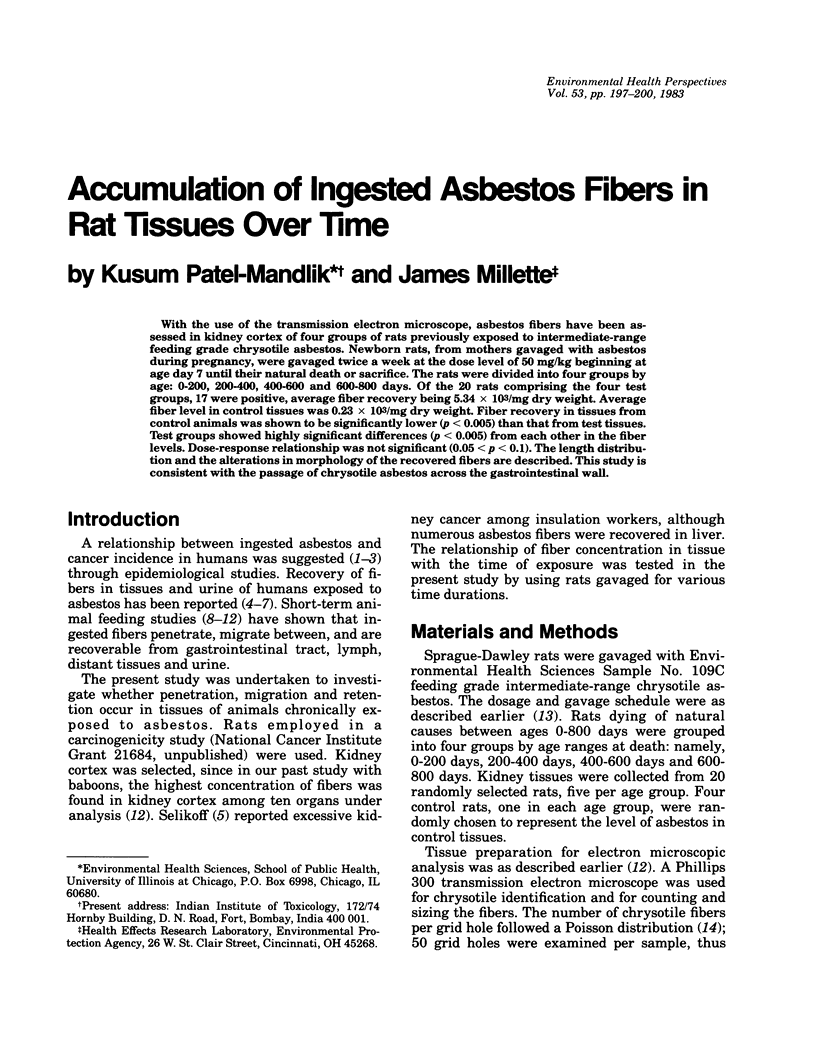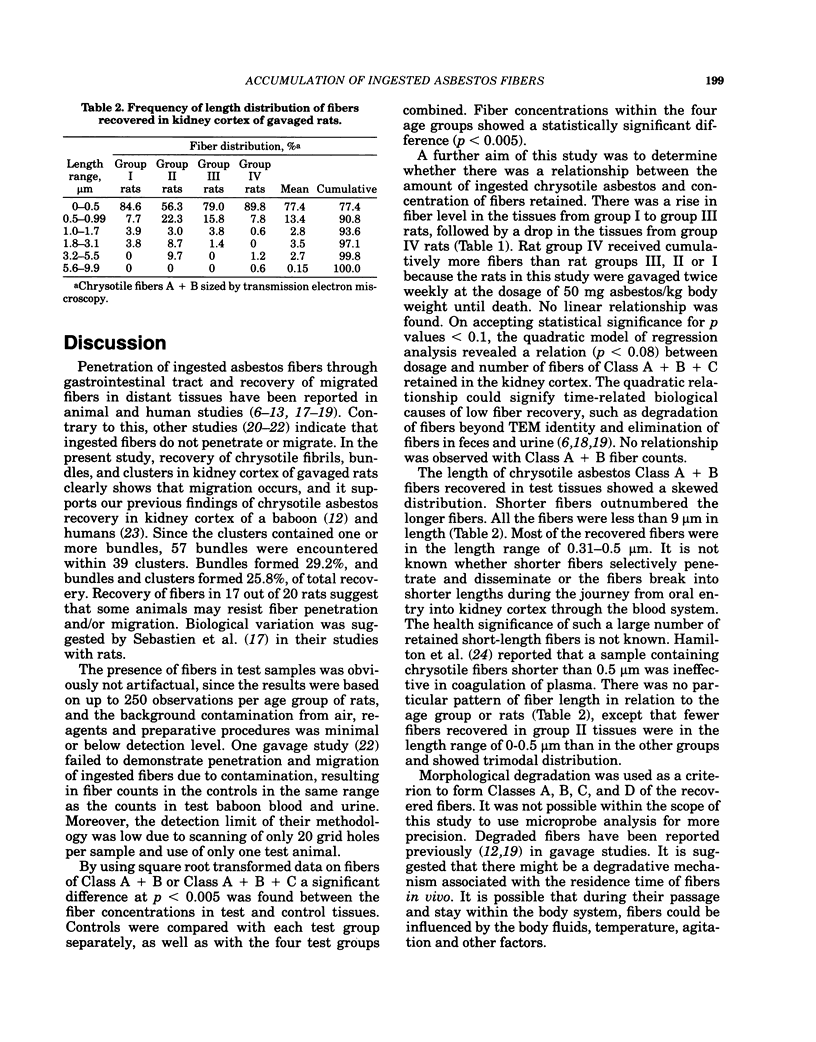Abstract
With the use of the transmission electron microscope, asbestos fibers have been assessed in kidney cortex of four groups of rats previously exposed to intermediate-range feeding grade chrysotile asbestos. Newborn rats, from mothers gavaged with asbestos during pregnancy, were gavaged twice a week at the dose level of 50 mg/kg beginning at age day 7 until their natural death or sacrifice. The rats were divided into four groups by age: 0-200, 200-400, 400-600 and 600-800 days. Of the 20 rats comprising the four test groups, 17 were positive, average fiber recovery being 5.34 X 10(3)/mg dry weight. Average fiber level in control tissues was 0.23 X 10(3)/mg dry weight. Fiber recovery in tissues from control animals was shown to be significantly lower (p less than 0.005) than that from test tissues. Test groups showed highly significant differences (p less than 0.005) from each other in the fiber levels. Dose-response relationship was not significant (0.05 less than p less than 0.1). The length distribution and the alterations in morphology of the recovered fibers are described. This study is consistent with the passage of chrysotile asbestos across the gastrointestinal wall.
Full text
PDF



Selected References
These references are in PubMed. This may not be the complete list of references from this article.
- Bolton R. E., Davis J. M. The short-term effects of chronic asbestos ingestion in rats. Ann Occup Hyg. 1976 Nov;19(2):121–128. doi: 10.1093/annhyg/19.2.121. [DOI] [PubMed] [Google Scholar]
- Carter R. E., Taylor W. F. Identification of a particular amphibole asbestos fiber in tissues of persons exposed to a high oral intake of the mineral. Environ Res. 1980 Feb;21(1):85–93. doi: 10.1016/0013-9351(80)90010-9. [DOI] [PubMed] [Google Scholar]
- Cook P. M., Olson G. F. Ingested mineral fibers: elimination in human urine. Science. 1979 Apr 13;204(4389):195–198. doi: 10.1126/science.219478. [DOI] [PubMed] [Google Scholar]
- Cunningham H. M., Moodie C. A., Lawrence G. A., Pontefract R. D. Chronic effects of ingested asbestos in rats. Arch Environ Contam Toxicol. 1977;6(4):507–513. doi: 10.1007/BF02097789. [DOI] [PubMed] [Google Scholar]
- Cunningham H. M., Pontefract R. D., O'Brien R. C. Quantitative relationship of fecal asbestos to asbestos exposure. J Toxicol Environ Health. 1976 Jan;1(3):377–379. doi: 10.1080/15287397609529337. [DOI] [PubMed] [Google Scholar]
- Gross P., Harley R. A., Swinburne L. M., Davis J. M., Greene W. B. Ingested mineral fibers. Do they penetrate tissue or cause cancer? Arch Environ Health. 1974 Dec;29(6):341–347. doi: 10.1080/00039896.1974.10666612. [DOI] [PubMed] [Google Scholar]
- Hallenbeck W. H., Markey D. R., Dolan D. G. Analyses of tissue, blood, and urine samples from a baboon gavaged with chrysotile and crocidolite asbestos. Environ Res. 1981 Aug;25(2):349–360. doi: 10.1016/0013-9351(81)90037-2. [DOI] [PubMed] [Google Scholar]
- Hallenbeck W. H., Patel-Mandlik K. J. Presence of fibers in the urine of a baboon gavaged with chrysotile asbestos. Environ Res. 1979 Dec;20(2):335–340. doi: 10.1016/0013-9351(79)90009-4. [DOI] [PubMed] [Google Scholar]
- Hamilton J. A., Chan J. Y., Movat H. Z. Coagulation of human plasma by asbestos fibers. Environ Res. 1981 Oct;26(1):119–124. doi: 10.1016/0013-9351(81)90190-0. [DOI] [PubMed] [Google Scholar]
- KEAL E. E. Asbestosis and abdominal neoplasms. Lancet. 1960 Dec 3;2(7162):1211–1216. doi: 10.1016/s0140-6736(60)92413-2. [DOI] [PubMed] [Google Scholar]
- Langer A. M., Selikoff I. J., Sastre A. Chrysotile asbestos in the lungs of persons in New York City. Arch Environ Health. 1971 Mar;22(3):348–361. doi: 10.1080/00039896.1971.10665854. [DOI] [PubMed] [Google Scholar]
- Patel-Mandlik K. J. Asbestos fibers in normal and cancerous human kidneys. Arch Environ Contam Toxicol. 1981;10(1):47–54. doi: 10.1007/BF01057574. [DOI] [PubMed] [Google Scholar]
- Patel-Mandlik K. J., Hallenbeck W. H., Millette J. R. Asbestos fibers: 1. A modified preparation of tissue samples for analysis by electron microscopy. 2. Presence of fibers in tissues of baboon fed chrysotile asbestos. J Environ Pathol Toxicol. 1979 Jul-Aug;2(6):1385–1395. [PubMed] [Google Scholar]
- Patel-Mandlik K. J., Millette J. R. Chrysotile asbestos in kidney cortex of chronically gavaged rats. Arch Environ Contam Toxicol. 1983 Mar;12(2):247–255. doi: 10.1007/BF01059588. [DOI] [PubMed] [Google Scholar]
- Patel-Mandlik K. J., Millette J. R. Evidence of migration of ingested asbestos into various baboon organs. Scan Electron Microsc. 1980;(Pt 1):347–354. [PubMed] [Google Scholar]
- SELIKOFF I. J., CHURG J., HAMMOND E. C. ASBESTOS EXPOSURE AND NEOPLASIA. JAMA. 1964 Apr 6;188:22–26. doi: 10.1001/jama.1964.03060270028006. [DOI] [PubMed] [Google Scholar]
- Sebastien P., Masse R., Bignon J. Recovery of ingested asbestos fibers from the gastrointestinal lymph in rats. Environ Res. 1980 Jun;22(1):201–216. doi: 10.1016/0013-9351(80)90132-2. [DOI] [PubMed] [Google Scholar]
- Selikoff I. J. Epidemiology of gastrointestinal cancer. Environ Health Perspect. 1974 Dec;9:299–305. doi: 10.1289/ehp.749299. [DOI] [PMC free article] [PubMed] [Google Scholar]
- Selikoff I. J., Hammond E. C., Seidman H. Mortality experience of insulation workers in the United States and Canada, 1943--1976. Ann N Y Acad Sci. 1979;330:91–116. doi: 10.1111/j.1749-6632.1979.tb18711.x. [DOI] [PubMed] [Google Scholar]
- Westlake G. E., Spjut H. J., Smith M. N. Penetration of colonic mucosa by asbestos particles. An electron microscopic study in rats fed asbestos dust. Lab Invest. 1965 Nov;14(11):2029–2033. [PubMed] [Google Scholar]


